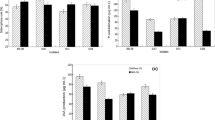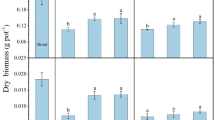Abstract
Use of heavy metal-tolerant bacteria for bioremediation is an environmentally safe and economical approach. Selected chromium-tolerant bacteria were tested in a greenhouse experiment. Different sets of pots were contaminated with three rates of Cr, i.e., 20, 30, and 40 ppm, using K2Cr2O7 and incubated for 1 month. Helianthus annuus (sunflower) seeds of Hysun-33 variety were inoculated with already screened Cr-tolerant bacteria (SS1, SS3, and SS6) along with un-inoculated seeds as control. Completely randomized design was used and two plants per pot were maintained after thinning. At harvesting, fresh as well as dry shoot and root weights were measured. Shoot and root samples were analyzed for Cr contents. The maximum increase in dry shoot and root weight (58 and 63%) was obtained by SS6 followed by SS1 (48 and 42%) and SS3 (37 and 47%) over control at various Cr concentrations. Cr accumulation in shoot and root was also enhanced by all the bacteria compared to control. Regarding the extent of total Cr uptake, SS6 enhanced Cr accumulation up to 107–171%, SS1 99.3–135%, and SS3 91–138% at 20, 30, and 40 ppm Cr, respectively. It is concluded from the study that there was a decreasing trend in growth with the increase of Cr concentration. All the bacteria improved growth and Cr accumulation significantly over control; however, SS6 found best among all Cr-tolerant bacteria. These bacteria can effectively be used for crop improvement and bioremediation.




Similar content being viewed by others
References
Abou-Shanab, R. A., Ghanem, K., Ghanem, N., & Al-Kolaibe, A. (2007a). The role of bacteria on heavy-metal extraction and uptake by plants growing on multi-metal-contaminated soils. World Journal of Microbiology and Biotechnology, 24(2), 253–262. doi:10.1007/s11274-007-9464-x.
Abou-Shanab, R. A., van Berkum, P., & Angle, J. S. (2007b). Heavy metal resistance and genotypic analysis of metal resistance genes in gram-positive and gram-negative bacteria present in Ni-rich serpentine soil and in the rhizosphere of Alyssum murale. Chemosphere, 68(2), 360–367. doi:10.1016/j.chemosphere.2006.12.051.
Amezcua-Allieri, M. A., Lead, J. R., & Rodríguez-Vázquez, R. (2005). Changes in Cd and Cr fluxes during the bioremediation of phenanthrene. Soil Use and Management, 21(3), 337–339. doi:10.1111/j.1475-2743.2005.tb00407.x.
Andaleeb, F., Zia, M. A., Ashraf, M., & Khalid, Z. M. (2008). Effect of chromium on growth attributes in sunflower (Helianthus annuus L.). Journal of Environmental Sciences, 20, 1475–1480.
Braud, A., Jezequel, K., Bazot, S., & Lebeau, T. (2009). Enhanced phytoextraction of an agricultural Cr- and Pb-contaminated soil by bioaugmentation with siderophore-producing bacteria. Chemosphere, 74(2), 280–286. doi:10.1016/j.chemosphere.2008.09.013.
Bric, J. M., Bostock, R. M., & Silverstone, S. E. (1991). Rapid in situ assay for indoleacetic acid production by bacteria immobilized on a nitrocellulose membrane. Applied and Environmental Microbiology, 57, 535–538.
Chigbo, C., & Batty, L. (2015). Chelate-assisted phytoremediation of Cu-pyrene-contaminated soil using Z. mays. Water, Air, & Soil Pollution, 226(3), doi:10.1007/s11270-014-2277-2.
Costa, M. (2003). Potential hazards of hexavalent chromate in our drinking water. Toxicology and Applied Pharmacology, 188(1), 1–5. doi:10.1016/s0041-008x(03)00011-5.
Dönmez, G., & Koçberber, N. (2005). Isolation of hexavalent chromium resistant bacteria from industrial saline effluents and their ability of bioaccumulation. Enzyme and Microbial Technology, 36(5–6), 700–705. doi:10.1016/j.enzmictec.2004.12.025.
El-Komy, H. M. A. (2005). Coimmobilization of Azospirillum lipoferum and Bacillus megaterium for successful phosphorus and nitrogen nutrition of wheat plants. Food Technology and Biotechnology, 43(1), 19–27.
Feldman, F. J., & Purdy, W. C. (1965). The atomic absorption spectroscopy of chromium. Analytica Chimica Acta, 33, 273–278.
Heidel, B., Rogge, T., & Scheffknecht, G. (2015). Controlled desorption of mercury in wet FGD waste water treatment. Applied Energy. doi:10.1016/j.apenergy.2015.05.016.
Huang, H., Wu, K., Khan, A., Jiang, Y., Ling, Z., Liu, P., et al. (2016). A novel Pseudomonas gessardii strain LZ-E simultaneously degrades naphthalene and reduces hexavalent chromium. Bioresource Technology, 207, 370–378. doi:10.1016/j.biortech.2016.02.015.
Jing, Y. D., He, Z. L., & Yang, X. E. (2007). Role of soil rhizobacteria in phytoremediation of heavy metal contaminated soils. Journal of Zhejiang University. Science. B, 8(3), 192–207. doi:10.1631/jzus.2007.B0192.
Karami, A., & Shamsuddin, Z. H. (2010). Phytoremediation of heavy metals with several efficiency enhancer methods. African Journal of Biotechnology, 9(25), 3689–3698.
Liu, R., Zhao, L., Jin, C., Xiao, N., Jadeja, R. N., & Sun, T. (2014). Enzyme responses to phytoremediation of PAH-contaminated soil using Echinacea purpurea (L.). Water, Air, & Soil Pollution, 225(12), doi:10.1007/s11270-014-2230-4.
Lone, M. I., He, Z. L., Stoffella, P. J., & Yang, X. E. (2008). Phytoremediation of heavy metal polluted soils and water: progresses and perspectives. Journal of Zhejiang University. Science. B, 9(3), 210–220. doi:10.1631/jzus.B0710633.
LyubunAffiliated, Y. V., Kosterin, P. V., Zakharova, E. A., Shcherbakov, A. A., & Fedorov, E. E. (2000). Arsenic-contaminated soils phytotoxicity studies with sunflower and sorghum. Journal of Soils and Sediments, 2(3), 143–147. doi:10.1065/jss2002.09.059.
Ma, Y., Rajkumar, M., & Freitas, H. (2009). Inoculation of plant growth promoting bacterium Achromobacter xylosoxidans strain Ax10 for the improvement of copper phytoextraction by Brassica juncea. Journal of Environmental Management, 90(2), 831–837. doi:10.1016/j.jenvman.2008.01.014.
Mahmood-ul-Hassan, M., Suthor, V., Rafique, E., Ahmad, R., & Yasin, M. (2012). Metal contamination of vegetables grown on soils irrigated with untreated municipal effluent. Bulletin of Environmental Contamination and Toxicology, 88(2), 204–209. doi:10.1007/s00128-011-0432-7.
Mohanty, M., Pattnaik, M. M., Mishra, A. K., & Patra, H. K. (2012). Bio-concentration of chromium—an in situ phytoremediation study at South Kaliapani chromite mining area of Orissa, India. Environmental Monitoring and Assessment, 184(2), 1015–1024. doi:10.1007/s10661-011-2017-7.
Mukhopadhyay, N., & Aery, N. C. (2000). Effect of Cr(III) and Cr(VI) on the growth and physiology of Triticum aestivum plants during early seedling growth. Biologia, 55(4), 403–408.
Nies, D. H. (2003). Efflux-mediated heavy metal resistance in prokaryotes. FEMS Microbiology Review, 27(2–3), 313–339. doi:10.1016/s0168-6445(03)00048-2.
Oh, K., Li, T., Cheng, H., He, X., & Yonemochi, S. (2013). Study on tolerance and accumulation potential of biofuel crops for phytoremediation of heavy metals. International Journal of Environmental Science and Development, 152–156, doi:10.7763/ijesd.2013.v4.325.
Oliveira, H. (2012). Chromium as an environmental pollutant: insights on induced plant toxicity. Journal of Botany, 2012, 1–8. doi:10.1155/2012/375843.
Ozdemir, G. (2004). Biosorption of chromium(VI), cadmium(II) and copper(II) by Pantoea sp. TEM18. Chemical Engineering Journal, 102(3), 249–253. doi:10.1016/j.cej.2004.01.032.
Park, D., Yun, Y. S., Ahn, C. K., & Park, J. M. (2007). Kinetics of the reduction of hexavalent chromium with the brown seaweed Ecklonia biomass. Chemosphere, 66(5), 939–946. doi:10.1016/j.chemosphere.2006.05.068.
Prasad. (2007). Sunflower (Helinathus annuus L.): a potential crop for environmental industry. Helia, 30(46), 167–174. doi:10.2298/hel0746167p.
Ramirez-Diaz, M. I., Diaz-Perez, C., Vargas, E., Riveros-Rosas, H., Campos-Garcia, J., & Cervantes, C. (2008). Mechanisms of bacterial resistance to chromium compounds. Biometals, 21(3), 321–332. doi:10.1007/s10534-007-9121-8.
Romeh, A. A., Khamis, M. A., & Metwally, S. M. (2015). Potential of Plantago major L. for phytoremediation of lead-contaminated soil and water. Water, Air, & Soil Pollution, 227(1), doi:10.1007/s11270-015-2687-9.
Shanker, A. K., Cervantes, C., Loza-Tavera, H., & Avudainayagam, S. (2005). Chromium toxicity in plants. Environmental International, 31(5), 739–753. doi:10.1016/j.envint.2005.02.003.
Sharma, A., Brar, M., & Malhi, S. (2005). Critical toxic ranges of chromium in spinach plants and in soil. Journal of Plant Nutrition, 28(9), 1555–1568. doi:10.1080/01904160500203382.
Sheng, X. F., & Xia, J. J. (2006). Improvement of rape (Brassica napus) plant growth and cadmium uptake by cadmium-resistant bacteria. Chemosphere, 64(6), 1036–1042. doi:10.1016/j.chemosphere.2006.01.051.
Sundaramoorthy, P., Chidambaram, A., Ganesh, K. S., Unnikannan, P., & Baskaran, L. (2010). Chromium stress in paddy: (i) nutrient status of paddy under chromium stress; (ii) phytoremediation of chromium by aquatic and terrestrial weeds. Comptes Rendus Biologies, 333(8), 597–607. doi:10.1016/j.crvi.2010.03.002.
Tiwari, K. K., Dwivedi, S., Singh, N. K., Rai, U. N., & Tripathi, R. D. (2009). Chromium(VI) induced phytotoxicity and oxidative stress in pea (Pisum sativum L.): biochemical changes and translocation of essential nutrients. Journal of Environmental Biology, 30(3), 389–394.
Yergeau, E., Sanschagrin, S., Maynard, C., St-Arnaud, M., & Greer, C. W. (2014). Microbial expression profiles in the rhizosphere of willows depend on soil contamination. ISME Journal, 8(2), 344–358. doi:10.1038/ismej.2013.163.
Yu, C., Peng, X., Yan, H., Li, X., Zhou, Z., & Yan, T. (2015). Phytoremediation ability of Solanum nigrum L. to Cd-contaminated soils with high levels of Cu, Zn, and Pb. Water, Air, & Soil Pollution, 226(5), doi:10.1007/s11270-015-2424-4.
Acknowledgements
The authors gratefully acknowledge National Agriculture Research Centre (NARC) and Hazara University Mansehra, Khyber Pakhtunkhwa, Pakistan, for providing research facilities.
Author information
Authors and Affiliations
Corresponding author
Rights and permissions
About this article
Cite this article
Bahadur, A., Afzal, A., Ahmad, R. et al. Influence of Metal-Resistant Rhizobacteria on the Growth of Helianthus annuus L. in Cr(VI)-Contaminated Soil. Water Air Soil Pollut 227, 467 (2016). https://doi.org/10.1007/s11270-016-3174-7
Received:
Accepted:
Published:
DOI: https://doi.org/10.1007/s11270-016-3174-7




